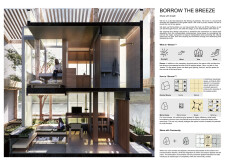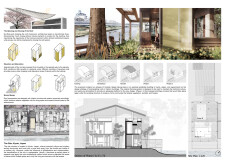5 key facts about this project
## Project Overview
"Borrow the Breeze" is a residential design initiative located in Kyoto, Japan, that harmonizes modern architectural practices with the natural environment. The project is developed with an intent to enhance the quality of living while respecting the historical and cultural context of the area. By fostering a connection between residents and their surroundings, the design aims to create a supportive community atmosphere.
## Spatial Configuration
The architectural layout employs a distinctive vertical organization, characterized by a combination of open and enclosed spaces that promote a fluid transition between indoor and outdoor environments. This arrangement emphasizes natural air circulation and cross-ventilation, facilitating improved comfort and health for residents. The two-level design enhances functionality while encouraging interaction and engagement among community members.
## Material Utilization
The choice of materials plays a crucial role in establishing the project’s identity, focusing on sustainability and aesthetic quality. Concrete is implemented for structural stability, providing longevity and resilience, while Kingspan UnQuad polycarbonate panels are used for moveable wall systems that allow for natural light and privacy. Plywood is integrated to bring warmth and texture to interior spaces, and the use of natural vegetation supports the project’s ecological goals. These material selections contribute to overall thermal comfort and environmental performance, reinforcing both functionality and aesthetic appeal.






















































